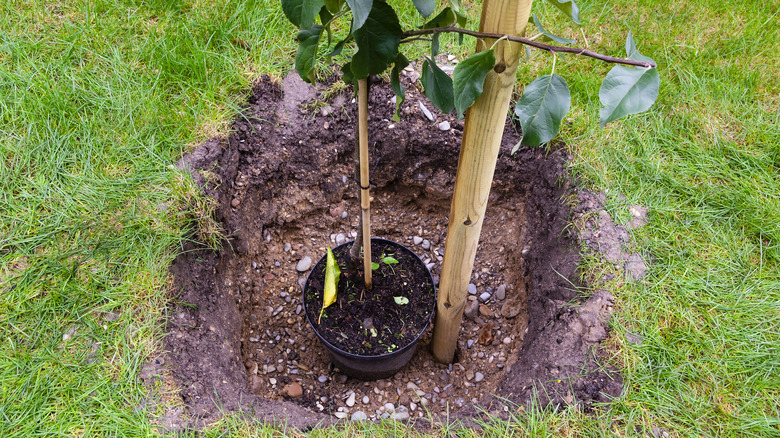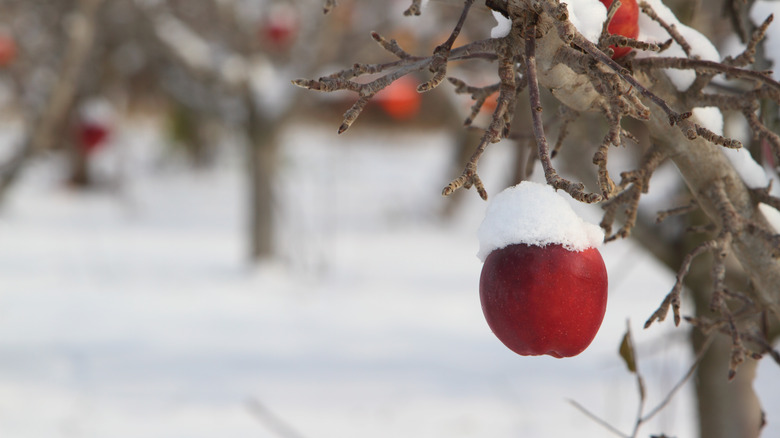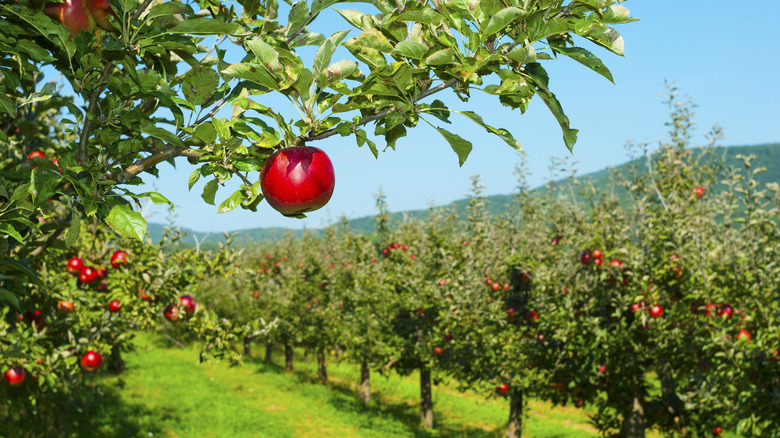The Best Time Of Year To Plant An Apple Tree, According To Our Professional Gardener
Planting an apple tree can be such a gratifying activity for gardeners. Knowing that the young tree will eventually bear fruit is an exciting thing to look forward to. But before young apple trees will bear fruit, they need to be properly planted and nurtured. While it's possible to plant an apple tree at nearly any time of year, the best time to plant depends on your local climate.
In northern climates, apple trees should be planted in mid-spring (after the danger of the last frost has passed). But in places with milder winters, early spring or late autumn are the best time. So, choosing the best planting time is best determined by knowing your growing zone. Obviously, for areas with cold winters, you want to choose a cold-hardy tree suitable for your growing zone. The Old Farmers' Almanac says that most apple trees grow best in USDA zones 3 to 8. Apple trees need "chill hours" in winter to form fruit. There are a number of apple trees suitable for zone 8 and higher.
Planting an apple tree at the appropriate time ensures that the tree will get a good start in suitable conditions of temperature and weather. It also means the apple tree will have ample time to establish its growth cycle and become acclimated to its new environment before extremes of seasonal weather or any potentially extreme weather conditions arrive (such as freezing temperatures or ice in winter, or heat and drought in summer).
When to plant apple trees in cold growing zones
There's a wide range of apple trees available for planting, which can be purchased at nurseries and from online suppliers. Since the growing zone is an important factor to consider when selecting your trees, this information will usually be available to guide you. If you live in zone 6 or lower (there are plenty of apple trees hardy to zone 3, including some heirloom apple trees), you probably have cold enough winters that you want to plant your apple trees in mid-spring.
By mid to late April, the danger of a late frost is mostly past, but keep an eye on the forecast, as occasionally we see some wintry weather as late as May. But unless the temperatures are well below freezing for more than two or three days, planting in mid to late April is good timing for these cold-hardy trees. As long as the soil isn't frozen and it's easy to dig a hole, planting your apple tree in mid-spring is great timing to give it a good start.
Once you plant and water your apple tree, give it a light layer of natural mulch to protect the soil and roots in case of heavy spring rains. It's recommended you plant at least two apple trees with different blossoming periods for pollination; a crabapple tree also makes a great pollinator and produces beautiful fragrant blossoms in spring and small fruits that attract songbirds.
Planting apple trees in warmer zones
Apple trees can be tricky to grow if you live in a growing zone that is USDA zone 10 or higher. You will have to search for a tree that will thrive in that zone; if there are not enough "chill hours" in the winter, your apple tree will not bear fruit. If you live in zone 8 or 9, there are some varieties you can try that need fewer chill hours (including Gala, a delicious apple that is fairly easy to find), but this means they blossom earlier, making them vulnerable in the event there is an occasional late spring frost. The recommended planting time for apple trees in warmer zones is a bit more flexible than for colder climates.
If your USDA zone is 6 or above, you can plant your apple tree in either late autumn or early spring. Most mail-order nurseries plan to ship apple trees in early spring. Waiting until late autumn may mean a smaller selection of trees available from mail-order companies, but you may be able to request a later shipping date if you communicate with the vendor.
Check the weather forecast and time your planting accordingly. Planting before some rain is okay, but heavy rain might disturb the new planting spot or cause it to become waterlogged. Adding a light layer of mulch over your newly planted tree will help protect the roots against any extremes of weather like heavy rain or an unexpected frost.


